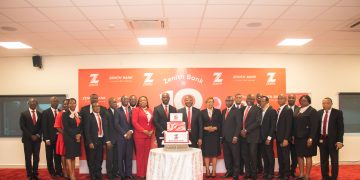Industry Performance
Figures published by the Bank of Ghana in 2016 indicate that total assets of the banking sector grew by 23.1 percent to GH¢63.30 billion as at end December 2015 compared with the 42.2 percent growth recorded in December 2014.
Domestic assets component of total assets increased by 24.1 percent to GH¢57.98 billion at the end of December 2015 compared with 39.9 percent growth recorded for the same period in 2014.
Growth in foreign assets slowed down from the 69.4 percent recorded in December 2014 to 12.5 percent growth in December 2015.
Net loans and advances of GH¢27.09 billion as at the end of December 2015 represented an annual growth of 22.0 percent compared with the 44.0 percent growth in the corresponding period a year earlier.
Banks’ investment portfolio (bills and securities) increased, in year-on-year terms, by 18.0 percent to reach GH¢14.26 billion by the end of December 2015 compared with the 11.2 percent growth at the end of December 2014.
The banking sector total deposits liabilities as at end December 2015 was GH¢41.26 billion and showed an annual growth of 27.2 percent compared with 39.0 percent growth in December 2014.
Banks’ borrowings recorded a slowdown in growth from 69.2 percent in December 2014 to 15.6 percent in December 2015. The slowdown in banks’ borrowings was driven mainly by sharp decline in banks’ long term foreign borrowings and contraction in short term foreign borrowing.
Banks’ paid-up capital also showed an annual growth of 20.7 percent to GH¢3.2 billion by the end of December 2015, compared with 13.1 percent growth in December 2014.
The pace in the year-on-year growth of shareholders’ funds slowed down from 38.4 percent in December 2014 to 24.2 percent in December 2015. The key developments in the banks’ balance sheet are provided in Table below.

PwC’s Research in 2014
In 2014, a research conducted by PriceWaterhouseCoopers (PwC) on Ghana’s banking industry showed that the industry grew by 32% from GHS25,755m in 2012 to GHS34,296m in 2013. The study titled, “2014 Ghana Banking Survey” attributed the growth to a 30% increase in deposits and borrowings.

Loans and advances remained the most significant component of the industry’s operating assets accounting for 43% of these assets. This has not changed from the prior year because of the limited opportunities for banks to extend credit to customers.
The general industry perception is that the risk profit of customers has not improved. This condition is further aggravated by the unfavourable macro-economic environment which is creating constraints for profit table business.
The prevailing high lending rates also continues to deter borrowers because of the inability to service the loans.
The survey further showed that the average base rates charged on lending during the year ranged between 10.6% by Baroda to 28.9% by BSIC. Cash holdings increased by 16% from GHS6,2711m in 2012 to GHS7,238m in 2013.
Investment holdings in money market instruments as liquid assets increased by 47% from GHS7,286m in 2012 to GHS10,722m in 2013. 87% of these money market instruments are held in Government of Ghana treasury bills and bonds. The favourable yield and less risky Government of Ghana securities make it the most attractive investment option in the light of the challenging economic condition.
EBG is the most dominant bank holding 13% of the industry’s operating assets. EBG’s continued dominance is an outcome of the synergy achieved from the merger with TTB which strengthened the customer base and an extended the branch network.
The gap between the EBG and GCB market share of operating assets continues to widen. Despite leading player in the industry with the widest branch network, GCB’s market share eroded from 11% as at end of 2012 t0 9.4% as at end of 2013.
The decline is an outcome of the intense competition in the industry as other banks are building their capacity and continue to target customers in the same market segment.
Stanbic grew its market share of the industry operating assets from 6.5% in 2011 and now holds 8.2% at the end of 2013. During that period Stanbic operating assets more than doubled from GHS1,117m in 2012 to GHS 2,818m in 2013, making it the fastest growing Bank in the industry. Stanbic shows tremendous success from its strategy to become a top tier bank. The strategy to stem loan losses and leverage on its corporate and investment banking to target the international clients is yielding results. UBA’s and ZBL’s operating assets grew by 121% and 104% respectively in 2013. The strong growth is an outcome of placements made by foreign banks.
UBA’s improved market share may not be sustained because funding from most of the placements are expected to be settled by the end of 2014. Unless these funds are rolled over, the bank is likely to liquidate the investments held in government securities on maturity. ZBL’s growth is arising from an increase in deposit and borrowings from other banks.
As a new entrant in 2013, FCPB has made significant in-roads in comparison with its peers with regard to market share. Unlike RBG and EBL, FCPB had operated for many years as a non-bank financial institution and had its own clientele in the predominantly informal sector of the economy. With the universal banking license secured, the bank is expected to become more aggressive in growing its operating assets and wield a greater market share.
The change in the market share of operating assets held by banks confirms the effect of competition in the industry over the years. Previously not considered significant, the threat to growth of the banking industry from proliferation of non-bank financial institution cannot be ignored.

The survey also indicated that deposits in the banking sector grew by 27% from GHS20,700m as at the end of 2012 to GHS26,336m as at end of 2013.
Competition for deposits during the year was intense as banks were further challenged by the attractive yield from money market instruments issued by the Government.
The current account component which constitutes 46% of total industry deposits only grew by 11%.
As the cheapest source of funds for banks the industry now has to rely on more expensive alternative sources of funds. Savings and time deposits grew by 26% despite the increasing trend to reduce the interest bearing deposits. The average rate offered to attract savings and time deposits ranged from 5% to 18% during 2013.
Deposits from other banks constituted 12% of industry deposits as at end of 2013. The market share of the industry’s deposits has not changed significantly because there is limited differentiation in the products offered by banks to give any bank a strong edge over the others.
All banks have made quality customer services their priority giving the banking industry a unique transformation. EBG gained significant market share in deposit holdings. EBG’s holds 74% of its deposits in current accounts and has been successful in maintaining deposits mix at fairly the same level of 71% as the prior year.
This puts EBG in a favourable position to post good operating results as cost of funds from current accounts are usually more favourable than those of savings and time deposits. EBG may be benefi tting from attention to customer care.
GCB lost market share of deposits from 11.3% as at end of 2012 to 10% as at end of 2013. GCB’s only held 45% of its deposits in current accounts. The deposits mix appears to be marginally skewed towards the relatively more expensive term and time deposit holding.
The extensive branch network across the country does not appear to have currently added an advantage for GCB in deposit mobilisation.
Other banks are becoming more visible, at least in the regional capitals where most economic activities in Ghana take place. Stanbic experienced 75% growth in deposit between end of 2012 and end of 2013.
It was mainly influenced by the deposits from other banks. The tenor of such placement is usually of very short term in nature. This may not be sustainable as long term funding for Stanbic’s growth aspirations. BOA lost market share of industry deposit as its deposit declined by 9%.
The bank may be struggling to achieve market visibility and inspire customer confidence.
FCPB, holds only 3% of its deposits in current accounts. The concentration in savings is historical. The bank had operated as a savings and loans company and relied on the deposits mobilised in the form of short term investments from its customers.
The trend may continue but may be diluted as it broadens and diversifies its source of deposits and seek cheaper sources of funds. Eventually this will positively impact on the pricing of FCPB’s loans. Notwithstanding, FCPB is better placed than most banks in the fourth quartile on the backdrop that 2013 is its first year in the banking industry.
Deposits from other banks increased three fold from GHS956m in 2012 to GHS 3,096m in 2013. The placements from banks over a short term between overnight and one month show an unusual trend as 86% of the placements is coming from the regional and multinational banks.
This may suggest that Group treasury activities by some of these banks considered it profitable to take positions in Ghana’s money market because of the gains it can derive from gains from both interest and changes in the foreign currency rates.
In very few cases placements were taken to shore up their liquidity position with the BoG. The market share of deposits by the top five banks; GCB, EBG, BBGL, SCB and Stanbic, accounts for 48%.
No significant change from 47% of total industry deposits in 2012. This trend which further deepens the concentration of deposits towards the top tier banks may be of concern because these banks can influence the deposit patterns and the deposit rates which can diminish the favourable effects that can be achieved by market forces.

































